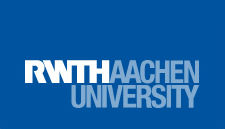Kategorie: ‘Gels’
Presentation
Tim Mrohs gave a presentation at the 59th Aachen Building Materials Day 2022 in Aachen, Germany entitled: ‘Low-acrylate gels for corrosion protection – theory’.
New publication:Resistance of crosslinkers in alkaline hydrogels

As part of our work on highly alkaline diallyldimethylammonium hydroxide (DADMAOH) hydrogels for the repair of mineral building materials, T. Mrohs and O. Weichold analysed the resistance of the four crosslinkers shown above. Classic amides such as N,N′-methylenebisacrylamide (BIS) decompose by slow hydrolysis, which leads to liquefaction of the gels. N,N,N′,N′-tetraallylpiperazinium dibromide (1b) decomposes surprisingly quickly due to chemical instabilities. In contrast, hydrogels with tetraallylammonium bromide (1a) or N,N,N′,N′,N′-tetraallyltrimethylene dipiperidinedibromide (1c) show no traces of degradation products even after 28 days at 60 °C. This corresponds to a shelf life of over 15 months at room temperature – sufficient for applications such as realkalisation or chloride extraction. These results show that such innovative materials are ideal for long-lasting construction applications.
T. B. Mrohs, O. Weichold
Hydrolytic Stability of Crosslinked, Highly Alkaline Diallyldimethylammonium Hydroxide Hydrogels
Gels 2022, 8, 669. https://doi.org/10.3390/gels8100669
New publication:
Gels as multifunctional repair materials
Alkaline hydrogels based on diallyldimethylammonium hydroxide (DADMAOH) can fulfil 3 important functions of repair materials for cracked concrete: Sealing of the crack to prevent water leakage, re-alkalisation of carbonated cement paste, which restores the alkali buffer, and re-passivation of steel reinforcement, which prevents corrosion of the reinforcement. In a proof-of-concept experiment, for example, the sealing properties of the gel were successfully tested on a cracked test specimen, where no leakage was observed under a water pressure of 5 metres for 28 days (WTA test W2.1-E).
A. Jung, O. Weichold
A 3-in-1 alkaline gel for the crack injection in cement-based materials with simultaneous corrosion protection and re-passivation of crack-crossing steel rebars
Construction Building Mater. 2022, 344, 128092. https://doi.org/10.1016/j.conbuildmat.2022.128092
New publication
New crosslinkers for diallylammonium gels
N,N’-methylene bisacrylamide (BIS) is a very popular crosslinker for radical polymerisation in water. It is highly reactive but tends to undergo alkaline hydrolysis and suffers from low solubility. This study shows that BIS forms only inhomogeneous networks with slowly polymerising systems such as N,N-diallyldimethylammonium chloride (DADMAC). As a result, gels with very low cross-linking densities, i.e. high swelling capacities, disintegrate during the swelling test. Coherent, i.e. highly cross-linked gels are not accessible due to the solubility limit. A promising alternative are multivalent tetraallyl compounds, such as tetraallylammonium bromide, N,N,N‘,N’-tetraallylpiperazinium dibromide and N,N,N‘,N’-tetraallyltrimethylenedipiperidinedibromide. In contrast to BIS, the copolymerisation with DADMAC is statistic. However, gelation with the new tetraallyl crosslinkers is much slower than with BIS and follows the order TAPB < TAMPB < TAAB, but the differences become significantly smaller as the content increases. At low contents, all three enable the production of gels with high swelling capacities of up to 360 g/g.
T. B. Mrohs, O.Weichold
Multivalent Allylammonium-Based Cross-Linkers for the Synthesis of Homogeneous, Highly Swelling Diallyldimethylammonium Chloride Hydrogels
Gels 2022, 8, 100. https://doi.org/10.3390/gels8020100
External impact

The publication ‘Alkaline hydrogels as ion-conducting coupling material for electrochemical chloride extraction’ by A. Jung, A. Faulhaber and O. Weichold in the journal Materials and Corrosion is one of the most downloaded articles in 2021. More.
Completed Master Thesis
Congratulations to Nils Münstermann on successfully completing his Master’s thesis entitled ‘Synthesis and properties of superabsorbers based on chitosan hydrogels’ in the Chemistry degree programme. The thesis is part of the ongoing Biosuperabsorber project.
New PhD Student
In April, we welcomed Tim Mrohs to the gels department. As part of his dissertation, he is researching hydrogels based on highly alkaline diallyldimethylammonium hydroxide (DADMAOH) for use in building preservation. He is focussing in particular on the development of alkali-stable crosslinkers and the formulation and investigation of molecular gel network structures. We wish him every success in his research and welcome him to the working group.
Completed Master Thesis
Congratulations to Tim Mrohs on successfully completing his master’s thesis in the field of alkaline hydrogels entitled ‘Synthesis of cross-linked copolymer electrolyte gels based on diallyldimethylammonium chloride and hydroxide’.



